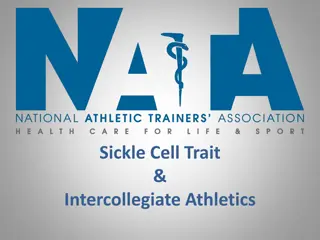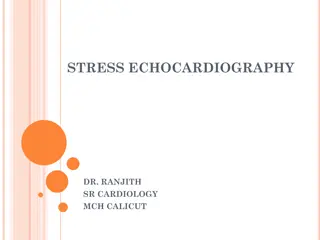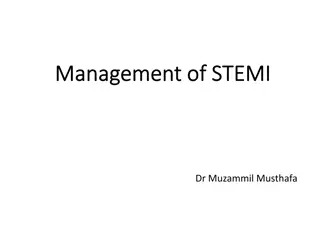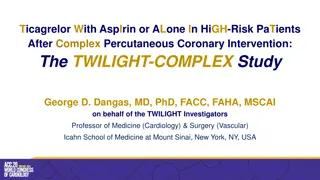Spoke 3 OPENCALLs
Introduction to the cascade calls for SPOKE3 ideas collected by WPs and partners, including budget and constraints discussions.
0 views • 19 slides
Region X HIV Programme
Overview of the Region X HIV Programme, including data on population, PLHIV, and the HIV care cascade. Mobilizing, testing, linkage, ART initiation, treatment and retention, challenges among specific populations, and other challenges are discussed.
6 views • 9 slides
Rapid Response to Ischemic Stroke: Assessment and Management
Learn about acute ischemic stroke diagnosis and initial prehospital and ED evaluation. Understand the importance of prompt action to improve patient outcomes. Images and guidelines provided.
1 views • 40 slides
Computational Physics (Lecture 18)
Neural networks explained with the example of feedforward vs. recurrent networks. Feedforward networks propagate data, while recurrent models allow loops for cascade effects. Recurrent networks are less influential but closer to the brain's function. Introduction to handwritten digit classification
0 views • 55 slides
Automated CT Perfusion Imaging in Acute Ischemic Stroke: Overview
This presentation delves into the significance of automated CT perfusion imaging in diagnosing and treating acute ischemic stroke. It covers essential information such as the burden of stroke in Ontario, the critical aspect of time in stroke treatment, hyperacute stroke treatment goals, and the impo
4 views • 41 slides
Understanding Neurogenic Speech and Language Disorders in Adults
This chapter provides insight into language disorders in adults, including types of aphasia, causes such as toxins, traumatic brain injury, brain tumors, and strokes. It discusses cerebral hemorrhage, occlusive strokes, ischemic stroke, transient ischemic attacks, and cerebral thrombosis. The conten
1 views • 34 slides
Ticagrelor Monotherapy vs. 12-Month Dual Anti-Platelet Therapy After Coronary Stent Implantation for ACS
The study compares the efficacy of ticagrelor monotherapy after less than 1 month of dual anti-platelet therapy (DAPT) to 12-month ticagrelor-based DAPT in patients with acute coronary syndrome (ACS) undergoing percutaneous coronary intervention (PCI) with drug-eluting stent implantation. The aim is
1 views • 19 slides
RLL Design and Sequencing System Overview
Common industrial sequences in RLL design and sequencing systems involve single path or multi-path approaches. Control signals can be sustain or non-sustain, impacting the system's memory. Sequence charts help visualize system operations, aiding in RLL design. Techniques like the CASCADE method are
13 views • 24 slides
Understanding Blood Clotting Factors in the Human Body
Blood clotting factors play a crucial role in the coagulation process to prevent excessive bleeding. Factors such as Fibrinogen (Factor-I), Prothrombin (Factor-II), Thromboplastin (Factor-III), Calcium Ions (Factor-IV), Labile Factor (Factor-V), and Stable Factor (Factor-VII) are essential for the c
7 views • 14 slides
Understanding Binary Counters and Types of Counters
Binary counters are registers used to count clock pulses, while binary counters follow the binary number sequence. There are two types of counters: serial/asynchronous counters and parallel/synchronous counters. Serial counters change output flip-flop to next flip-flop, requiring minimal hardware bu
12 views • 21 slides
Understanding Coagulation Profile in Hemostasis
Coagulation profile testing is crucial in assessing blood clotting ability. The process of coagulation is essential for hemostasis to prevent bleeding or clotting disorders. This summary explores the steps involved in hemostasis, the clotting cascade, and the triggers for the extrinsic and intrinsic
6 views • 14 slides
SISTER Study: Improving Stroke Treatment Response with TS23
SISTER Study led by Eva Mistry aims to identify a safe and effective dose of TS23 for treating ischemic stroke patients with core-penumbra mismatch. The Phase-2 trial involves 300 adults and spans 54 months, with primary endpoints focusing on treatment efficacy and safety. The study is randomized, p
0 views • 22 slides
Understanding Sickle Cell Trait in Intercollegiate Athletics
Sickle cell trait is a hereditary condition affecting red blood cells' shape and oxygen-carrying capacity. Individuals with this trait can experience complications during intense exercise, leading to health risks in athletics. This article explores the impact of sickle cell trait on athletes, the re
0 views • 15 slides
Understanding Association and Causation in Epidemiological Studies
Exploring the concepts of association and causation in epidemiological studies, this content delves into the complexities of determining if exposure leads to disease risk. It discusses different types of associations, such as spurious, indirect, and direct causal associations, illustrating the chall
5 views • 43 slides
Clinical Update: 2021 AHA/ASA Guideline for Stroke Prevention
This clinical update provides guidance adapted from the 2021 AHA/ASA Guideline for the Prevention of Stroke in Patients with Stroke and Transient Ischemic Attack. It categorizes recommendations based on strength and quality of evidence, outlining levels of recommendation and evidence for different c
0 views • 43 slides
Understanding Cerebrovascular Accidents (CVAs) and Their Effects
Learn about the fundamentals of CVAs, the common types - Ischemic and Hemorrhagic, left brain vs. right brain functions, effects on different brain hemispheres, and assessments and treatments for patients. Explore insightful questions related to post-CVA observations. The content also covers various
0 views • 17 slides
Managing Diabetes in Pregnancy: Preconception and Post-conception Care
Providing preconception care for women with established type 1 or type 2 diabetes is crucial for ensuring a healthy pregnancy. This involves counseling on effective contraception, evaluating and treating diabetes-related complications, reviewing risks of uncontrolled diabetes during pregnancy, and d
0 views • 37 slides
Comprehensive Guide to Stress Echocardiography in Cardiology Practice
Stress echocardiography is a valuable tool in diagnosing and managing coronary artery disease, valvular heart disease, and assessing heart function. This imaging technique helps in detecting flow-limiting stenosis, understanding the ischemic cascade, and evaluating cardiac function during stress. Va
0 views • 49 slides
Understanding Cascade Amplifiers and Their Applications
Cascade amplifiers are two-port networks designed with amplifiers connected in series, providing enhanced signal strength in various applications such as TV receivers and tuned RF amplifiers. These amplifiers use multiple stages to amplify the overall voltage gain, overcoming limitations of single-s
0 views • 15 slides
NHS Leadership Academy Staff Cascade Meeting Updates - May 2019
An overview of the NHS Leadership Academy staff cascade meeting held in May 2019, encompassing updates on organizational changes, feedback requests, and discussions on system planning, long-term plan implementation, and performance oversight. The meeting emphasized the importance of workforce collab
0 views • 9 slides
Understanding Soft Gamma-Ray Emissions from Pulsar Polar Caps
Soft gamma-ray emissions from the polar cap cascade region are a subject of interest in astrophysics, with studies focusing on the fundamental physical processes of pulsars and potential origins of non-thermal X-ray emissions. Researchers explore the emission processes, polar cap accelerators, casca
0 views • 16 slides
Comprehensive Treatment Guidelines for Acute Ischemic Stroke
In the management of acute ischemic stroke, the primary goals are to reduce secondary brain damage, maintain adequate perfusion, and prevent recurrent strokes by managing risk factors. Treatment includes maintaining tissue oxygenation, correcting volume status and electrolytes, managing blood glucos
0 views • 20 slides
Impact of Extending Acute Stroke Triage Criteria to 24 Hours
Landmark trials have extended the therapeutic time window for mechanical thrombectomy for acute ischemic stroke patients. This study evaluates the impact of implementing a protocol change to extend the time window at a comprehensive stroke center. Retrospective analysis compared stroke alerts and ke
1 views • 8 slides
Ticagrelor Added to Aspirin in Acute Non-Severe Ischemic Stroke or TIA of Atherosclerotic Origin
Among patients with transient ischemic attack (TIA) or minor ischemic strokes, adding ticagrelor to aspirin has shown superior efficacy in preventing stroke or death, particularly in those with ipsilateral atherosclerotic stenosis. The THALES trial demonstrated that ticagrelor added to aspirin was m
0 views • 14 slides
Understanding Neonatal Seizures and Their Pathophysiology
Neonatal seizures are sudden changes in neurologic function of a newborn, involving motor, behavior, and autonomic functions. The pathophysiology includes delays in Na/K ATPase maturation, increased receptor density, and GABAergic transmission. Different types of seizures like subtle, clonic, tonic,
1 views • 24 slides
If you are looking for African american haircut in Cascade
If you are looking for African american haircut in Cascade, Another Planet Barber Club is Top Rated - Multi Award Winning Celebrity Barber in Provo, Utah! Greetings... I am Sci-Fi! The half alien\/astronaut barber from Another Planet & I come in peac
0 views • 6 slides
Understanding Antianginal Drugs and Treatment Options
Recognize the variables contributing to balanced myocardial supply and demand, identify etiopathogenic cascades in ischemic heart disease, and learn about drugs for acute angina relief and prophylaxis. Delve into the pharmacology of nitrates, vasodilators, and other antianginal therapies. Explore th
2 views • 18 slides
Overview of Acute Coronary Syndrome and Myocardial Infarction
Acute Coronary Syndrome (ACS) encompasses a spectrum of conditions involving reduced blood flow in the heart. Ischemic Heart Disease (IHD) is a leading cause of mortality worldwide, with ST-elevation myocardial infarction (STEMI) being more common in younger men. Prompt diagnosis, treatment, and adh
1 views • 73 slides
Novel Imaging in Stable Ischemic Heart Disease
Learn about the application of quantitative PET/CT imaging for diagnosing and managing stable ischemic heart disease and coronary microvascular dysfunction in symptomatic patients through this insightful talk by Dr. Viviany Taqueti. Discover the limitations of conventional approaches, implications f
0 views • 10 slides
CASCADE Project: Climate Adaptation & Development Support
CASCADE is a two-year project funded by DG ECHO aimed at developing a macro-regional approach for climate change risks in the Baltic Sea Region. The project focuses on risk assessment, treatment, and capacity building to enhance urban risk management related to climate change. It involves civil prot
0 views • 8 slides
Collaborative Implementation of Alma/Primo System in Orbis Cascade Alliance
Central Oregon Community College and other institutions in the Orbis Cascade Alliance worked together to select and implement the Alma/Primo system for efficient library management. The consortium, consisting of 37 universities, colleges, and community colleges in Oregon, Washington, and Idaho, leve
0 views • 15 slides
High-Sensitivity Cardiac Troponin in Stable Ischemic Heart Disease
Study by Nicholas Marston, MD, and team shows that high-sensitivity cardiac troponin at any detectable concentration is linked to a higher risk of major cardiovascular events in patients with stable ischemic heart disease. The research, conducted through the PEGASUS-TIMI 54 trial, aimed to further u
0 views • 17 slides
Understanding Diabetic Foot Ulcers: Causes, Types, and Treatment
Diabetic foot ulcers are a common complication among diabetic patients, leading to disability and hospital admissions. The ulcers can be caused by factors like neuropathy and ischemia. Identifying the types, such as neuropathic and ischemic ulcers, helps in determining appropriate treatment, which m
0 views • 12 slides
Understanding Cascade Control Systems in Industrial Processes
Cascade control systems play a crucial role in improving process control efficiency by incorporating feedback loops within feedback loops. This type of control architecture helps to better handle disturbances and variations in the process by creating secondary loops that monitor specific parameters.
0 views • 8 slides
Ticagrelor Monotherapy vs. Ticagrelor + Aspirin in High-Risk PCI Patients: TWILIGHT-COMPLEX Study
Patients undergoing complex PCI are at high risk of ischemic events. The TWILIGHT-COMPLEX study aims to compare the safety and efficacy of ticagrelor monotherapy versus ticagrelor with aspirin in patients who completed 3 months of DAPT post-PCI. While extended DAPT may reduce ischemic events, it als
0 views • 27 slides
National J.A.M. Competition: Tropic Cascade - The Religion of Nature by Law College Dehradun
Law College Dehradun, under the faculty of Uttaranchal University, presents the National J.A.M. Competition on "Tropic Cascade: The Religion of Nature" organized by Vasundhara - The Green Society. The event aims to foster legal, scientific, and ethical knowledge while promoting environmental awarene
0 views • 10 slides
Understanding Autonomic Nervous System and Clinical Applications in Medicine
This academic session covers the effect of autonomic nervous system stimulation on various systems, clinical diseases, pathophysiological changes, disease management guidelines, and clinical applications of autonomic drugs. Common clinical applications of autonomic receptors agonists and antagonists
0 views • 23 slides
Understanding the LARC Capability Maturity Model for Organizational Improvement
The LARC Capability Maturity Model (CMM) focuses on enhancing the viral load cascade, aiming to achieve better patient outcomes and improve institutional capabilities for viral load scale-up. Developed by Carnegie-Mellon University Software Engineering Institute in 1987, the CMM provides a structure
0 views • 14 slides
Understanding the Clotting Cascade and Hemostasis
The clotting cascade is a complex process involving intrinsic and extrinsic pathways that converge to form fibrin, leading to clot formation. Hemostasis is initiated mainly through the extrinsic pathway in vivo, activating factors that generate thrombin and ultimately convert fibrinogen into insolub
0 views • 11 slides
Understanding Atherosclerosis and Peripheral Artery Diseases
Atherosclerosis is a progressive process triggered by an inflammatory response, often aggravated by hypertension. Conditions like claudication and critical limb ischemia are indications of inadequate blood flow, posing risks of rest pain and ischemic ulcers. Recognizing symptoms like pain, numbness,
0 views • 4 slides







































